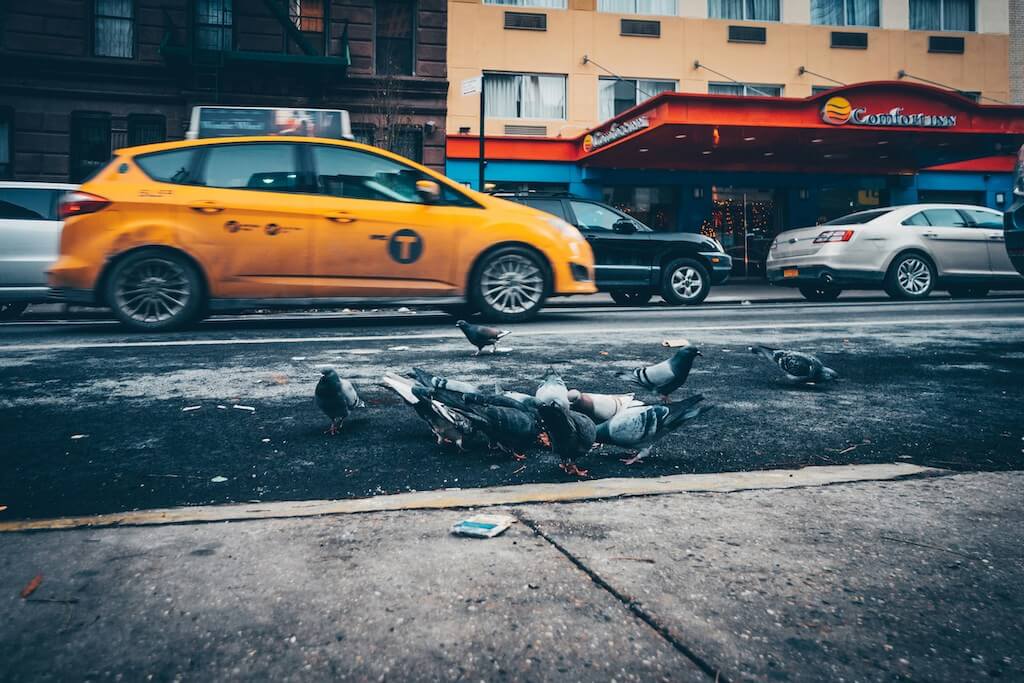Autumn Gear Guide
Find inspiration in our Gear Guide that will keep you out on your bike through wind or rain.
Download NowBike lane obstacles come in all shapes and sizes. Yes, protected cycling infrastructure is the best as protection from motor vehicles is the key to getting more people to make the modal shift to bicycles and doing so safety. But just because there is a cement curb separating cyclists from other traffic doesn’t mean the […]
Bike lane obstacles come in all shapes and sizes. Yes, protected cycling infrastructure is the best as protection from motor vehicles is the key to getting more people to make the modal shift to bicycles and doing so safety. But just because there is a cement curb separating cyclists from other traffic doesn’t mean the safety issues are over. As discussed in a recent online forum, bike lane obstacles range from pigeons and cabbies to… well, let’s find out.
To successfully navigate urban bike paths and bike lanes, cyclists must anticipate potential hazards and react swiftly. When confronted with a stubborn pigeon unwilling to yield its feeding spot, cyclists should approach cautiously and be prepared to alter their course if necessary. Delivery drivers navigating tight spaces can be unpredictable, so maintaining a safe distance and being ready to brake or swerve is essential. Similarly, keeping an eye out for parked taxi cabs and avoiding riding too close to them can help cyclists avoid collisions caused by suddenly opened doors.
When faced with imminent danger, cyclists must execute evasive maneuvers to avoid collisions. Swerving around a stationary pigeon, giving wide berth to a delivery truck making a delivery, or safely passing a parked taxi cab are all skills urban cyclists must master. When encountering distracted pedestrians, maintaining a safe following distance and being prepared to slow down or stop if necessary can prevent accidents. The important point is that bicyclists, despite some protection from a bike lane, need to always be prepare for and expect that worst.
Here is a look at some of the obstacles that have been encountered as discussed in a recent post on the online forum Reddit with quotes.
Tourists: Often unaware of their surroundings and can suddenly step into the bike lane.
Pigeons: Always present pecking away at scraps, and never interested in moving. “George Costanza flashed through my mind avoiding pigeons. LOL – “We had a deal!”

Very territorial geese: Aggressive birds that won’t move for anything, posing a hazard to cyclists. “Geese in Boston are so fearless. Not so much aggressive, but they will not move for anything.”
Fallen trees, branches: Obstacles on the road that cyclists must maneuver around.
People running with their headphones in: “Runners in bike lanes is my current pet peeve.”
E-scooters: Increasingly common and can clutter bike lanes, requiring cyclists to navigate around them.
Broken plastic sticks meant for protection: Leftover debris from car collisions that obstructs the bike lane.
Food delivery riders: Often in their own bubble, posing a hazard by stopping or turning suddenly.
Bugs: Occasionally fly into cyclists’ paths, causing discomfort or even injury. “And that is why I use a neck gaiter, there is nothing like the taste of dragonfly to wake you up on your morning commute.”
Lizards: Numerous and prone to hurling themselves into the path of cyclists. “And on certain stretches of road or sidewalk all the lizards seem to take turns hurling themselves into the path of destruction. Weird.”
Crows: Big birds can cause damage, beware. “I took a crow to the helmet once, hard enough to jerk my head back as far as it could go. That was an actual bike lane.”
Homeowner garbage bins: Litter the bike lane on designated pick-up days, obstructing cyclists’ paths.
Wooly bears (caterpillars): Small but soul-crushing when hit by a cyclist.
Wet Leaves: In the fall, decomposing piles of slimy leaves are serious hazards.
Roller skiers in both directions: Take up space in bike lanes, making it difficult for cyclists to pass.
Spiders: Not as much in bike lanes, but on trails with tree branches and other low-hanging obstacles. “Almost completely separated my shoulder hitting a concrete barrier after riding through a spider web with the creepiest looking spider I’ve ever seen.”
Discarded rental electric scooters: Left in bike lanes, creating obstructions for cyclists.
Phone-distracted parents with toddlers: Their children may wander into the bike lane, posing a hazard.
Banana peels: Unusual but occasionally found in bike lanes, creating a slipping hazard.
Bunnies: Startled by cyclists’ presence and may run into their path, requiring quick maneuvering. “I once had a rabbit dart underneath my bike and between my wheels. I think he was showing off.”
Remaining calm and composed is crucial when navigating bike lanes and paths. By staying focused and alert, cyclists can react quickly and make split-second decisions with confidence. Managing adrenaline levels and maintaining a positive mindset are essential for safely navigating the challenges of city cycling.
Mastering the art of dodging on urban bike paths requires skill, practice, and a keen awareness of one’s surroundings. Stay safe! Let us know in the comments any other unique obstacles you’ve encountered!
Find inspiration in our Gear Guide that will keep you out on your bike through wind or rain.
Download Now
Leave a comment